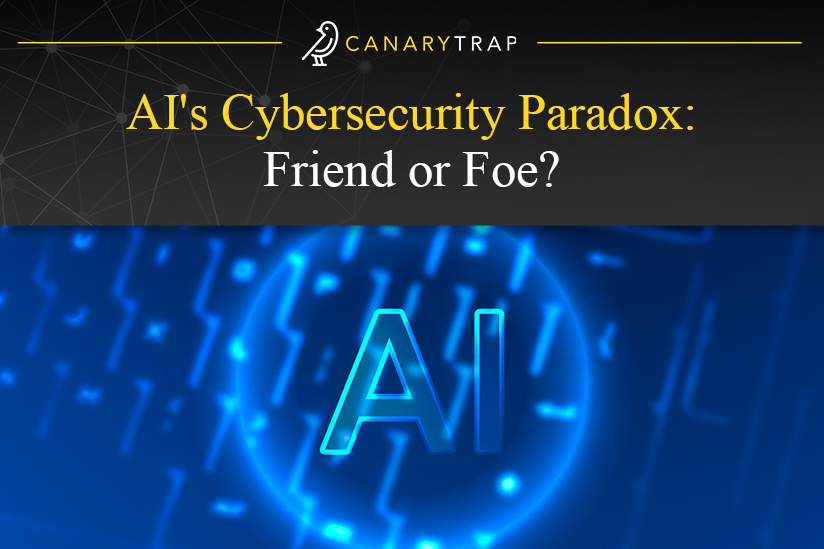AI’s Cybersecurity Paradox: Friend or Foe?
- June 7, 2024
- Canary Trap
AI’s cybersecurity has become a paradox in the digital age. As Artificial Intelligence (AI) continues to evolve into a cornerstone of modern technology, it has transformed various industries by enhancing efficiency, accuracy, and decision-making processes. From autonomous vehicles and personalized marketing to advanced data analysis and healthcare diagnostics, AI’s capabilities continue to expand, driving significant advancements across the globe. As AI systems become more integrated into daily operations, the importance of robust cybersecurity measures cannot be overstated. With an increasing reliance on digital platforms and the internet, protecting sensitive information and critical infrastructure from cyber threats is paramount.
In the realm of cybersecurity, AI presents a double-edged sword. On one hand, it serves as a powerful tool that enhances threat detection, response times, and predictive analytics, helping organizations stay ahead of potential attacks. AI-driven cybersecurity solutions can analyze vast amounts of data in real-time, identifying patterns and anomalies that human analysts might miss. This capability is crucial in mitigating risks and ensuring the safety of digital environments.
On the other hand, AI also poses significant threats when leveraged by cybercriminals. AI-powered attacks, such as sophisticated phishing schemes, deepfakes, and automated hacking tools, present new challenges for security professionals. The very attributes that make AI beneficial—its speed, efficiency, and ability to learn—can also be exploited to create more effective and harder-to-detect cyber threats. Thus, understanding AI’s dual nature in cybersecurity is essential for developing comprehensive strategies to harness its potential while mitigating its risks.
The Role of AI in Enhancing Cybersecurity
Artificial Intelligence plays a crucial role in enhancing cybersecurity by significantly improving threat detection capabilities and utilizing predictive analytics to prevent cyberattacks. Traditional cybersecurity methods often struggle to keep pace with the rapid evolution of cyber threats. However, AI-powered systems can analyze vast amounts of data in real-time, identifying patterns and anomalies that indicate potential security breaches. Machine learning algorithms can continuously learn from new data, allowing AI systems to adapt to emerging threats and enhance their detection accuracy over time.
An article published by Encryption Consulting points out that “Smart AI solutions give information about threats and explain the details to the security team. This extra information helps the team respond quickly and effectively, making the overall response to incidents better.”
Furthermore, it was also highlighted how AI works differently, explaining that “AI in cybersecurity goes beyond traditional methods, changing how organizations protect their systems and data. By using AI and cybersecurity together, security professionals get better at spotting problems, dealing with threats before they become big issues, and using smart automation to stay ahead of cyber threats in a world that’s always changing.”
AI improves threat detection capabilities by employing advanced techniques such as behavior analysis, anomaly detection, and pattern recognition. These techniques enable AI systems to detect unusual activities that deviate from established norms, flagging them for further investigation. For instance, AI can identify unauthorized access attempts, unusual network traffic, and potential malware infiltration by analyzing user behavior and network patterns. This proactive approach helps organizations detect threats early, minimizing the potential damage caused by cyberattacks.
Moreover, predictive analytics is a powerful tool in AI’s arsenal for cyberattack prevention. By leveraging historical data and machine learning models, AI can predict potential security incidents before they occur. Predictive analytics can forecast future attack vectors, identify vulnerabilities, and assess the likelihood of different types of attacks. This foresight allows organizations to implement preventive measures, such as patching vulnerabilities and reinforcing security protocols, to thwart potential attacks.
AI can significantly enhance cybersecurity by improving threat detection capabilities and employing predictive analytics for proactive defense and as cyber threats continue to evolve, integrating AI into cybersecurity strategies becomes increasingly essential for organizations to protect their digital assets and maintain robust security postures.
The Risks of AI in Cybersecurity
While AI offers numerous benefits for enhancing cybersecurity, it also introduces significant risks. AI-powered cyberattacks and the use of deepfakes and social engineering represent some of the most concerning threats in this evolving landscape.
- AI-Powered Cyberattacks
AI-Powered Cyberattacks are becoming increasingly sophisticated as cybercriminals harness the power of artificial intelligence to develop more effective and elusive attack strategies. AI can automate and enhance traditional hacking techniques, making attacks faster and more difficult to detect. For example, AI-driven malware can adapt its behavior to avoid detection by traditional security systems, while AI algorithms can be used to identify and exploit vulnerabilities in a network more efficiently than human hackers.
Additionally, AI can be used to automate phishing attacks. As mentioned in a Medium article, cybercriminals can use AI automation to “create hyper-realistic phishing campaigns, and even predict human behavior to breach […] defenses. Phishing emails crafted with uncanny precision, manipulating emotions and exploiting vulnerabilities with chilling accuracy.”
- Deepfakes and Social Engineering Threats
These kinds of cyber threats have been on the rise as of late and pose another significant risk in the AI-driven cybersecurity landscape. Deepfake technology, which uses AI to create realistic but fake audio, video, or image content, can be exploited to impersonate individuals and deceive users. For instance, deepfakes can be used to create fake videos of company executives giving fraudulent instructions, leading to unauthorized financial transactions or data breaches. This technology undermines trust in digital content and can have severe consequences for businesses and individuals.
Social engineering, which relies on manipulating individuals into divulging confidential information, is also being enhanced by AI. Cybercriminals can use AI to analyze social media profiles, emails, and other personal data to craft highly targeted and convincing social engineering attacks, tricking individuals into revealing passwords, financial information, or other sensitive data and leading to significant security breaches.
To mitigate these risks, it is crucial for organizations to stay informed about the latest AI-driven threats and implement robust security measures. This includes conducting regular security training for employees and establishing strong verification processes to detect and prevent deepfake-related fraud.
As it was questioned in a Systems Cloud article, “the deployment of AI in cybersecurity opens up a Pandora’s box of ethical dilemmas. How much autonomy should AI have in decision-making? What about privacy concerns when AI analyzes sensitive data? And let’s not forget the potential for AI systems to be exploited by the very threats they’re designed to combat. Navigating these waters requires a delicate balance between leveraging AI’s capabilities and safeguarding digital ethics. Like any technology, its impact is shaped by how we use it.”
While AI has the potential to significantly enhance cybersecurity, it also introduces new risks that must be carefully managed. By understanding and addressing the threats posed by AI-powered cyber attacks and deepfakes, organizations can better protect themselves in the digital age.
Strategies for Mitigating AI-related Risks
As AI technology continues to evolve, it is imperative to develop effective strategies to mitigate AI-related risks in cybersecurity. Addressing these risks requires a multifaceted approach that includes enhancing security measures for AI systems and fostering collaboration and regulation efforts.
Enhancing security measures for AI systems involves several key actions:
- Robust Testing and Validation
Implement comprehensive testing and validation processes to ensure AI systems are secure and perform as expected. This includes regular security audits and vulnerability assessments.
- Data Protection
Ensure that the data used to train AI models is secure. Implement encryption, access controls, and data anonymization techniques to safeguard sensitive information.
- Continuous Monitoring
Establish continuous monitoring protocols for AI systems to detect and respond to security incidents in real-time. This involves using AI-driven security solutions that can adapt to evolving threats.
The human touch is still a crucial component of the cybersecurity strategies. As mentioned in a VulnerX article, “As AI gets smarter, it’s all about teamwork. AI’s great at crunching numbers and spotting trouble, but us humans bring the creativity, ethics, and strategic thinking to the table. When things get hairy, we need human smarts to make the tough calls.”
That’s why collaboration and regulation efforts are also essential to create a secure AI environment:
- Industry Collaboration
Encourage collaboration between organizations, cybersecurity experts, and AI developers to share knowledge, best practices, and threat intelligence. This collective effort can lead to the development of more robust security frameworks.
- Regulatory Compliance
Adhere to regulatory standards and guidelines for AI and cybersecurity. Engage with policymakers to shape regulations that address AI-related risks and promote ethical AI development.
- Public-Private Partnerships
Foster partnerships between public and private sectors to enhance information sharing and joint efforts in combating AI-driven cyber threats.
- Ethical AI Practices
Promote the development and use of AI technologies that prioritize ethical considerations and transparency. Establish ethical guidelines for AI development to ensure accountability and responsibility.
By enhancing security measures for AI systems and fostering collaboration and regulation, organizations can effectively mitigate AI-related risks. These strategies are crucial for maintaining a secure and trustworthy AI-driven cybersecurity landscape.
In Conclusion
AI’s dual role in cybersecurity presents both opportunities and challenges. On one hand, AI enhances threat detection, automates responses, and provides predictive analytics to prevent cyber-attacks. On the other hand, AI-powered attacks, deepfakes, and social engineering threats highlight the risks associated with its misuse.
As we navigate the complexities of AI in cybersecurity, it is crucial to adopt robust security measures for AI systems and promote collaboration between organizations, governments, and researchers. Ethical considerations must be at the forefront to ensure that AI development aligns with principles of fairness and transparency.
Now, it is safe to conclude that answers regarding AI’s role in cybersecurity can’t be all black and white, so AI is both a friend and foe in this realm. Embracing its potential while remaining vigilant against its threats is essential for a secure digital future. It is imperative for stakeholders to work together, continuously innovate, and remain proactive in addressing the evolving landscape of cyber threats. The future of cybersecurity depends on our collective efforts to harness AI responsibly and effectively.
SOURCES:
- https://www.encryptionconsulting.com/the-role-of-artificial-intelligence-ai-in-modern-cybersecurity/
- https://medium.com/@abi19raami/the-rise-of-ai-in-cybersecurity-friend-or-foe-0e3e28428923
- https://www.systemscloud.co.uk/post/the-rise-of-ai-in-cybersecurity-friend-or-foe
- https://vulnerx.com/ai-cybersecurity-careers-future-proof/

